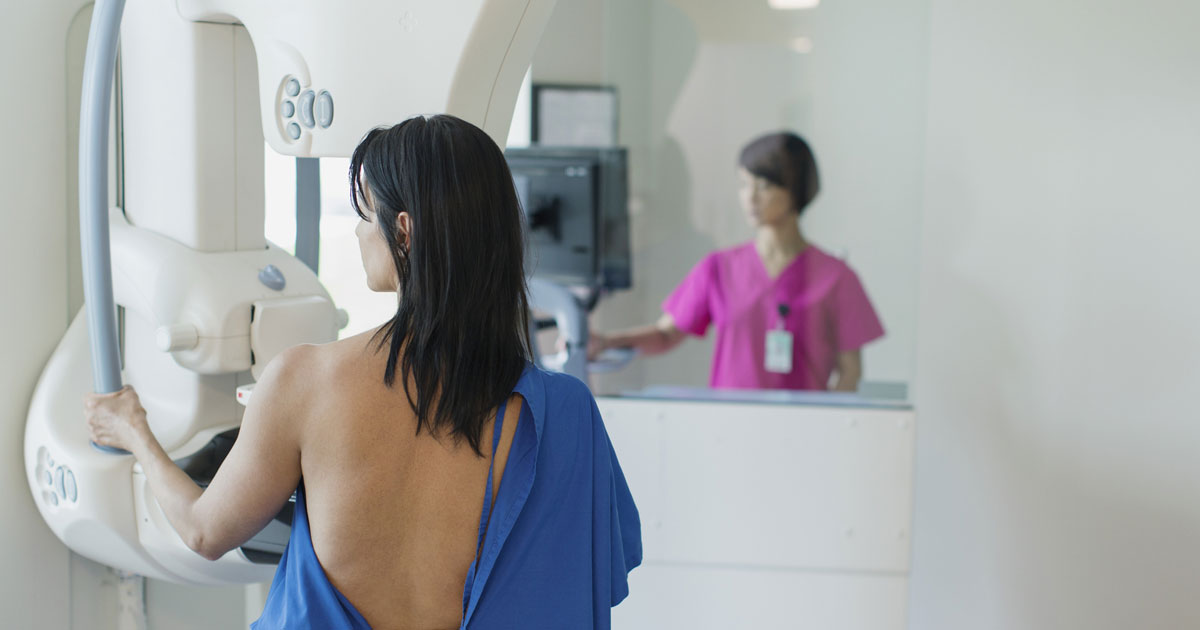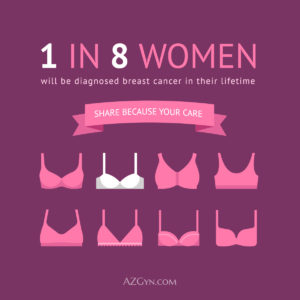Many women ask about when to get a mammogram. Adults in the US are subject to frequently changing guidance regarding many health screening procedures – particularly those involving women. So, it’s no surprise that many women wonder if it’s time to get a mammogram as they approach their 40s. It’s not uncommon for women who have never had a mammogram to have additional questions surrounding the procedure, as well.
Most women in this age range lead busy and hectic lives, and for some, preventative health care is often far down on the to-do list. However, as women approach middle age, it becomes more important to speak to a doctor about scheduling a mammogram appointment in the future. For women over the age of 40, the time to schedule a mammogram may be right now, especially for those with a family history of breast cancer and those who are otherwise considered to have a high risk for developing breast cancer.
Learn more information about scheduling a mammogram from your friends at Arizona Gynecology Consultants.
Should I Get a Mammogram?
The decision to get a mammogram should be made during a consultation with a doctor. This decision should consider your personal medical history, family history of breast cancer, and other risk factors. The answer to this question is a personal one, and there are determining factors that can suggest the recommended window you should get a mammogram, such as age, genetic predisposition, self-examination, and your doctor’s physical examination. Consult with your doctor to determine the ideal timing for your mammogram screening.
For patients who are within the 40+ age range, have a family history of breast cancer, or have the breast cancer gene, now is a good time to have that conversation with your healthcare provider. In addition, if you are using hormones, if you’ve had breast surgeries, or if you’ve had a cancer diagnosis in the past, share this information with your doctor.
Why Mammograms Are So Important
Mammograms are important because they can detect early signs of breast cancer more effectively than self-check breast exams and doctor breast exams. In fact, mammograms can catch breast cancer long before a lump is apparent, when it’s much easier to treat. The purpose of a mammogram is to identify abnormalities in the breast and determine if additional testing such as another mammogram and/or a biopsy, is necessary to identify or rule out potential cancerous tissue. There are four changes in breasts that mammograms can identify—calcifications, masses, asymmetries, and distortions—all of which are potential indications of cancer.
Mammograms are crucial for finding small cancers early when prospective treatment outcomes are the best. Breast cancer can potentially be an aggressive disease and can advance significantly in a short time. Therefore, monthly self-exams are also important for identifying potential issues between mammograms. Women who are familiar with the way their breasts normally feel can detect symptoms and abnormalities more easily, but it is also critical to get mammograms, especially if you haven’t been conducting regular self-exams.
When combined to form a comprehensive breast care routine, self-check breast exams, annual doctor’s exams, and mammograms are all effective tests, even for those who do not have an increased risk of breast cancer. Tests establish the healthy norm and make it easier to tell when slight differences occur.
Should I Get a Mammogram FAQ

Consider the following information to determine whether you should ask your doctor about scheduling a mammogram.
Q: At What Age Should You Start Getting Regular Mammograms?
A: As a general guideline, women over the age of 40 and those at higher risk of breast cancer can benefit from routine mammograms. Women under 40 with a family history of breast cancer or other risk factors may need to start getting mammograms earlier. In general, it is important for women 35 and up to talk to their doctor to determine the right screening plan for them.
Q: How Often Should a Woman Get a Mammogram?
A: The frequency of mammograms is also a matter of professional medical recommendation and can vary depending on an individual’s age, health history, and other risk factors.
Here are some general guidelines:
- Most women aged 40 to 74 need only get a mammogram every two years.
- Women at elevated risk due to strong family history, genetic predisposition, prior chest radiation, or other risk factors may need to start getting mammograms earlier, have them more frequently, or have additional screening tests such as magnetic resonance imaging (MRI).
It is important to note that these are just general guidelines. Your doctor may have a different recommendation based on your unique medical situation.
Q: At What Age Do You No Longer Need a Mammogram?
A: Women aged 75 and older may be able to schedule less frequent mammograms or stop them altogether. However, again, women in this age group should discuss the continued need for mammograms with their doctor, as the benefits and risks may change with age. In general, depending on a patient’s medical history, women aged 75 and older may not need to continue their routine exams.
How Fast Can Breast Cancer Develop?
While the rate of cancer growth and development of cancer tissues is specific to the individual patient and depends on a multitude of factors, a study suggests that the average breast cancer doubles in size in about 1.5 years. However, some cancers in the study took under two months to double. This indicates that cancers are unique, so some cancers are much more aggressive and grow much faster. Thus, it is a possibility that cancer that developed after a mammogram screening could be aggressive enough to progress significantly between mammograms.
Interval Cancers
Interval cancers are breast cancers that are discovered in between mammograms. These are typically volatile cancers that may be at a higher stage or grade and larger in size when discovered than those cancers detected in screening. This is because they have developed rapidly within the 11 to 23 months between routine mammograms.
Breast Awareness
It should be noted that women who are “breast aware” are more likely to detect changes in the breast tissue or notice other symptoms when between mammogram screenings. If they can identify masses early enough, these women have better prognosis than those patients who are not breast aware and do not perform regular self-breast exams. This indicates the importance of monthly self-checks and familiarization with one’s own body, even if you are receiving routine mammograms.
Getting Your First Mammogram
If you’ve determined that you are in or near the correct age bracket to get a mammogram or are otherwise at risk of developing breast cancer, it’s time to have a conversation with your doctor. Together, you can determine the right time to start routine mammograms and establish a schedule for regular mammogram screening over time. Then, you’ll schedule an appointment for your first mammogram screening.
There is research-based evidence that indicates mammograms should be, whenever possible, scheduled during the first week of the patient’s menstrual cycle. While this is not always practical or possible, especially for women getting their first breast cancer screening, mammogram results may be more accurate when performed during the first half of the menstrual cycle. One reason for this is that this is when breast tissue is less dense since it is more difficult to detect breast cancer through dense breast tissue.
Preparing For a Mammogram
After you schedule your mammogram, it is important not to allow yourself to become nervous or upset as your appointment day approaches. Most mammograms serve to reassure those that receive them that no cancer is present. Only about two to four mammograms per 1,000 result in a breast cancer diagnosis.
If you’ve scheduled an appointment, the doctor or medical practice conducting the mammogram screening will go over the procedure and may recommend certain actions to take leading up to the appointment. Some recommendations for preparing for the appointment are below.
Before a mammogram, you should:
- Avoid using antiperspirants, deodorants, powders, creams, perfumes, or lotions on the armpits or under the arm on the day of the exam, as they can show up as white spots on the x-ray and interfere with results.
- Wear a two-piece outfit since clothing will need to be removed above the waist.
- Bring a list of questions to ask the radiologist or technologist.
It is also important to tell the technologist at the onset of the exam if there have been any recent changes or issues with your breasts, if you have breast implants, if you are breastfeeding, if you think you might be pregnant, or if you have trouble standing still alone and/or use a cane to walk or stand.
What to Expect at a Mammogram Exam

Once the mammogram is ready to begin, you and the technician will be the only ones in the room. You will be asked to undress and given a wrap to wear during the exam. To get a high-quality image, the breasts must be compressed or flattened. The technologist will place your breast on the machine, and it will be pressed between the machine and an upper plate made of plastic. The plate is lowered to compress the breast for 10 or 15 seconds per image.
The technician will take a minimum of two images of each breast, though more images may be needed if the breasts are larger or if you have implants. The technician will reposition the breast and re-compress it to take images of each side. The sequence is then repeated on the other breast. There may be discomfort or slight pain during the compression. If you feel pain, you should notify the technician so the compression can be adjusted to be more comfortable.
During the exam, it’s important to relax and take deep breaths. Mindful breathing is typically all that is necessary to get you through this quick and relatively painless procedure. Any minor discomfort is well worth detecting breast cancer early, which can often have a more favorable outcome than leaving cancer unchecked and untreated.
After the Mammogram Exam
Your healthcare provider will receive the full results of the mammogram screening after it is completed. If you have not heard from your doctor within ten days, you should call the provider or the facility where the exam took place. Patients who have online access to their medical records may also be able to review the results there. Mammography facilities, however, must provide patients with a summary of their results in an easy-to-understand format within 30 days. Go over the results with your healthcare provider and ask questions if there is anything you do not understand.
Schedule a Consultation

Arizona Gynecology Consultants recommends that women over 40 schedule regular mammograms every two years. If you have a family history of breast cancer or another risk factor, consult with one of our physicians to create a custom mammography schedule that addresses those risks.
Our experienced professionals are proud to support breast health and breast health education. Preventative care is the best way to identify breast cancer and other breast health issues as early as possible for the best prognosis. If you are over 40 and have not yet scheduled a mammogram, or are otherwise concerned with your breast health, contact Arizona Gynecology Consultants and schedule a consultation.
Sources
- https://www.cancer.gov/types/breast/research/interval-breast-cancer
- https://www.cancer.org/cancer/breast-cancer/screening-tests-and-early-detection/mammograms/mammogram-basics.html
- https://www.mayoclinic.org/tests-procedures/mammogram/expert-answers/mammogram-guidelines/faq-20057759
- https://pubs.rsna.org/doi/abs/10.1148/radiol.10100974
- https://breast-cancer-research.biomedcentral.com/articles/10.1186/bcr2092

Nurse Practitioner
Fulfilling her dream of becoming a nurse practitioner Nikkeya Boyd joined Arizona Gynecology Consultants in 2019. She completed her undergraduate studies at the University of Missouri in St. Louis and her graduate work at Grand Canyon University graduating in 2018.








 Research consistently reports strong links between alcohol consumption and cancer risk, and women who consume three alcoholic drinks per week face a 15% increase in breast cancer risk. Cancer researchers also report that for every drink beyond three per week increases this risk by an additional 10%***. Young girls between the ages of 9 and 15 also face a significantly higher risk of developing benign breast lumps if they consume three to five alcoholic drinks per week. Drinking alcohol can also increase the risk of breast cancer returning in women who received early-stage breast cancer diagnoses.
Research consistently reports strong links between alcohol consumption and cancer risk, and women who consume three alcoholic drinks per week face a 15% increase in breast cancer risk. Cancer researchers also report that for every drink beyond three per week increases this risk by an additional 10%***. Young girls between the ages of 9 and 15 also face a significantly higher risk of developing benign breast lumps if they consume three to five alcoholic drinks per week. Drinking alcohol can also increase the risk of breast cancer returning in women who received early-stage breast cancer diagnoses.